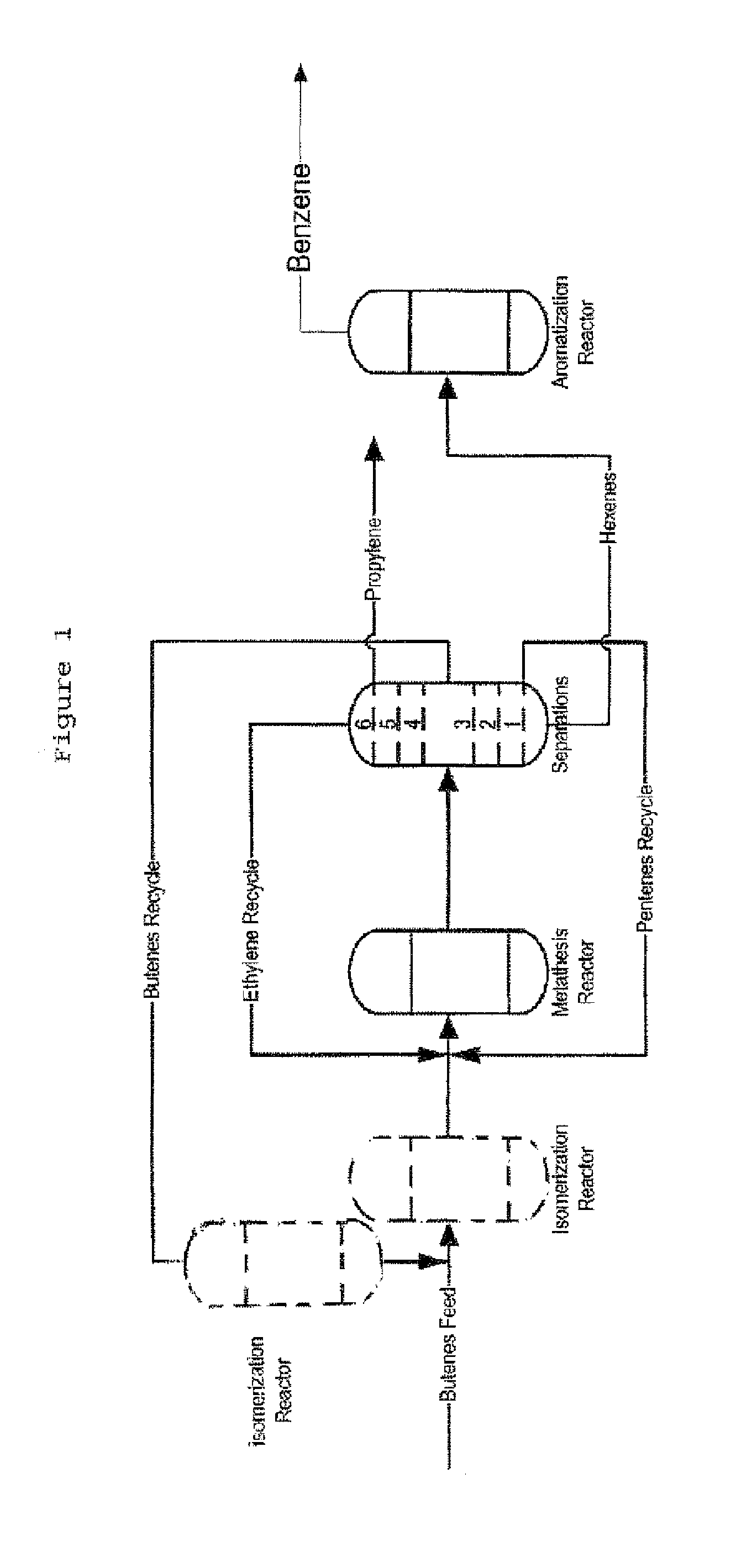Process for producing propylene and aromatics from butenes by metathesis and aromatization
a technology of aromatics and butenes, which is applied in the direction of hydrocarbon preparation, hydrocarbon preparation, molecular sieve catalysts, etc., can solve the problems of impeded commercialization of butene metathesis
- Summary
- Abstract
- Description
- Claims
- Application Information
AI Technical Summary
Benefits of technology
Problems solved by technology
Method used
Image
Examples
example 1
Re Catalyst at 48° C., 25% 1-butene
[0038]The feed with a 1-butene / 2-butene molar ratio of 1:3 was passed continuously through a catalyst bed of Re2O7 on alumina (10 wt % Re-metal) which was maintained at 48° C. The catalyst was previously activated in air at 500° C. Reaction product analysis after 24 hours time on stream revealed a total butenes conversion of 43% with an equilibrium distribution of products. The selectivity towards propylene was found to be 49% while the selectivity towards hexenes was 4%. The ratio of cis-3-hexene to trans-3-hexene was found to be 1:6. A comparison between the calculated equilibrium product distribution and the observed values is shown in FIG. 2.
example 2
Re Catalyst at 48° C., 75% 1-butene
[0039]The feed with a 1-butene / 2-butene molar ratio of 3:1 was passed continuously through the catalyst bed of Re2O7 on alumina (10 wt % Re-metal) which was maintained at 48° C. The catalyst was previously activated in air at 500° C. Reaction product analysis after 19 hours time on stream revealed a total butenes conversion of 59% with an equilibrium distribution of products. The selectivity towards propylene was found to be 46% while the selectivity towards hexenes was 20%. Again, the ratio of cis-3-hexene to trans-3-hexene was found to be 1:6. A comparison between the calculated equilibrium product distribution and the observed values is shown in FIG. 3.
example 3
Co / Mo Catalyst at 97° C., 50% 1-butene
[0040]The feed with a 1-butene / 2-butene molar ratio of 1:1 was passed continuously through the catalyst bed of CoO / MoO3 on alumina (3.5 wt % CoO, 14 wt % MoO3) which was maintained at 97° C. The catalyst was previously activated in nitrogen at 500° C. Reaction product analysis after 9 hours time on stream revealed a total butenes conversion of 57% with an equilibrium distribution of products. The selectivity towards propylene was found to be 46% while the selectivity towards hexenes was approximately 10%. A comparison between the calculated equilibrium product distribution and the observed values is shown in FIG. 4.
PUM
| Property | Measurement | Unit |
|---|---|---|
| pressure | aaaaa | aaaaa |
| temperature | aaaaa | aaaaa |
| temperature | aaaaa | aaaaa |
Abstract
Description
Claims
Application Information
 Login to View More
Login to View More - R&D
- Intellectual Property
- Life Sciences
- Materials
- Tech Scout
- Unparalleled Data Quality
- Higher Quality Content
- 60% Fewer Hallucinations
Browse by: Latest US Patents, China's latest patents, Technical Efficacy Thesaurus, Application Domain, Technology Topic, Popular Technical Reports.
© 2025 PatSnap. All rights reserved.Legal|Privacy policy|Modern Slavery Act Transparency Statement|Sitemap|About US| Contact US: help@patsnap.com



